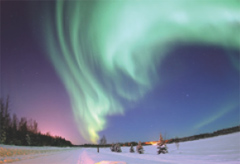이달 과학동아에는 캐나다 옐로나이프의 오로라 화보가 실렸다. 아름다운 경관을 만들어내는 오로라에 대한 글을 읽고 해석해 보자.
Auroras, sometimes called the northern and southern (polar) lights are beautiful light displays in the sky, usually observed at night, particularly in the polar regions. The northern lights have had a number of names throughout history. The Cree people, one of the largest groups of Aboriginals in North America, located mainly across Canada, call this phenomenon the ‘Dance of the Spirits’. In the middle ages the auroras had been regarded as a sign from God.
In northern latitudes, the effect is known as the aurora borealis, named after the Roman goddess of dawn, Aurora, and the Greek name for north wind, Boreas. The aurora borealis is also called the northern polar lights, as it is only visible in the sky from the Northern Hemisphere, with the chance of visibility increasing with proximity to the North Magnetic Pole(Earth's is currently in the arctic islands of northern Canada).
Auroras seen near the North pole may be high overhead, but from further away, they illuminate the northern horizon as a greenish glow or sometimes a faint red, as if the sun were rising from an nusual direction. Its southern counterpart, the aurora australis or the southern polar lights, has similar properties, but is only visible from high southern latitudes in Antarctica, South America, or Australasia. The term ‘Australis’ came from the Latin word for ‘of the South’, thus the ‘aurora of the South’.
Auroras can be spotted throughout the world and on other planets. It is most visible closer to the poles due to the longer periods of darkness and the magnetic field. Auroras typically occur in the ionosphere. Auroras are the result of the emissions of photons in the Earth's upper atmosphere, above 80km, from ionized nitrogen atoms regaining an electron, and oxygen and nitrogen atoms returning from an excited state to ground state. They are ionized or excited by the collision of solar wind particles. The excitation energy is lost by the emission of a photon of light, or by collision with another atom or molecule.
Typically the aurora appears either as a diffuse glow or as ‘curtains’ that approximately extend in the east-west direction. At some times, they form ‘quiet arcs’; at others, they evolve and change constantly. Each curtain consists of many parallel rays, each lined up with the local direction of the magnetic field lines. This fact suggests that aurora is shaped by Earth's magnetic field.
해석
오로라는 무엇인가?
북극광과 남극광이라고도 불리우는 오로라는 주로 밤에 특히 극지방에서 관찰되는 아름다운 빛의 연출이다. 북극광은 역사에 걸쳐 많은 이름을 가져왔다. 북미대륙에서 가장 큰 규모의 원주민 집단 중 하나였으며 주로 캐나다 지역에 걸쳐 거주한 크리족은, 이 현상을 ‘영혼의 춤’이라 불렀다. 중세에는 신의 계시로 간주되기도 했다.
북위 지역에서는 로마신화의 새벽의 여신 오로라와 북풍을 지칭하는 그리스어 명칭인 보리아스를 따서, ‘오로라 보리알리스’라고 불렸다. 오로라 보리알리스는 또한 북극광이라 불리우기도 하는데 그 이유는 오로라가 북반구의 하늘에서만 관측되기 때문이며, 북자극에 가까이 갈수록 더 잘 보이기 때문이다(현재 지구의 북자극은 캐나다 북쪽에 위치한 북극해의 한 섬이다).
북극점에서 보이는 오로라는 머리 위에 높게 떠 있다. 그러나 북극점에서 멀리 떨어져서 보면, 마치 다른 방향에서 일출과 일몰이 일어나는 것처럼, 북쪽 지평선을 녹색빛으로 또는 은은한 붉은색으로 밝힌다. 남반구에서는 오로라 오스트랄리스, 혹은 남극광이 비슷한 현상을 발한다. 그러나 남극광은 남극대륙이나 남미대륙, 혹은 호주나 오스트랄라시아의 고위도 지역에서만 관측된다. ‘오로라 오스트랄리스’에서 ‘오스트랄리스’는 남쪽을 의미하는 라틴어에서 왔다. 따라서 오로라 오스트랄리스는 남쪽의 오로라라는 의미다.
오로라는 전 세계에서 관측되며 다른 행성에서도 관측된다. 오로라가 극지점에 가까울수록 잘 보이는 이유는 극지방에서 오랫동안 어둠이 지속되며 지구 자기장의 영향을 받기 때문이다. 오로라는 전형적으로 전리층에서 발생한다. 오로라는 지구 대기권 상층부 80km 위에서 일어나는 현상이며, 이온화된 질소원자가 전자를 다시 갖게 될 때, 산소나 질소원자가 들뜬 상태에서 바닥상태로 돌아가면서 발생한다. 이러한 원소들이 이온화되고 들뜬 상태가 되는 이유는 태양풍의 입자들과 충돌하기 때문이다. 여기된 에너지는 광자를 배출하며 에너지를 잃거나 다른 원자 혹은 분자와 충돌하면서 소모된다.
반적으로 오로라는 빛이 은은하게 확산된 광휘(光輝)로 관측되거나, 혹은 동서 방향으로 뻗은 커튼처럼 관측된다. 때로 ‘조용한 아크방전’을 형성하기도 하며 끊임없이 진화하고 변화한다. 각각의 커튼처럼 보이는 오로라는 수많은 평형 입자선으로 구성되며, 그 지역의 자기장 방향을 따라 형성된다. 이러한 사실은 오로라가 지구의 자기장 때문에 형성된다는 것을 암시하고 있다.


















